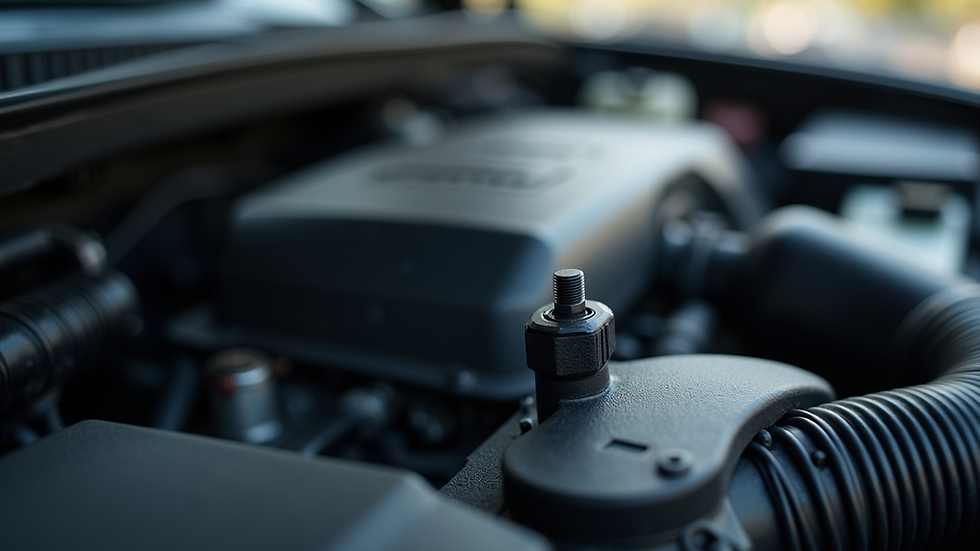How to Check Your Oil Level and Safeguard Your Engine Against Costly Repairs
- Tim's Auto Flapper 🗣️

- Apr 30
- 4 min read
Ensuring your vehicle’s engine runs smoothly is vital for its longevity and performance. One of the most basic yet crucial tasks in vehicle maintenance is checking your oil level. Motor oil lubricates engine parts, reduces friction, and aids in regulating temperature. Neglecting your oil levels can lead to severe engine damage and expensive repairs. In this guide, we’ll walk you through the steps to properly check your oil level, ensuring your engine remains protected.
Why Checking Your Oil Level is Important
Regularly monitoring your oil level is an essential part of vehicle maintenance. Think of oil as your engine’s lifeblood. A low oil level can cause inadequate lubrication, leading to premature wear and potential engine failure. For example, research shows that about 70% of engine wear occurs during the first few minutes of operation, making proper oil levels critical.
Proper oil maintenance can enhance your car’s fuel efficiency by up to 2%. By keeping a close eye on your oil, you can prevent costly repairs down the road and ensure your vehicle performs optimally.
Tools You'll Need
Before diving in, gather these simple tools:
Oil Dipstick: This instrument indicates your oil level.
Paper Towel or Cloth: Essential for cleaning the dipstick after checking the oil.
Funnel (if you need to add oil): Ensure it’s clean to avoid contamination.
Having these items ready will streamline the process.
Steps to Check Your Oil Level
Step 1: Prepare Your Vehicle
Begin by parking on a flat surface and turning off the engine. It’s best to check your oil level when the engine is cold for an accurate reading. Allow a few minutes for the oil to settle in the oil pan after stopping the engine.
Step 2: Locate the Dipstick
Open the hood and find the oil dipstick. It usually features a brightly colored handle (often yellow or orange), making it easy to identify.

Step 3: Remove the Dipstick
Slowly pull the dipstick out and wipe it clean with your paper towel or cloth. This step is crucial as it ensures you won’t read any residual oil from previous checks.
Step 4: Reinsert and Check
After cleaning, reinsert the dipstick fully into the tube, then pull it out again to check the oil level. Observe the markings, which typically indicate "Low" and "Full." If the oil level is below the “Low” mark, you need to add oil. If it’s near the "Full" mark, your oil level is good.

Step 5: Assess Oil Condition
Besides checking the level, evaluate the oil's color and texture. Clean oil is typically amber and clear. If the oil looks dark or has a gritty texture, an oil change is due. For instance, if your oil resembles black tar, it’s a sign that it’s time for a change.
Step 6: Adding Oil (if necessary)
If you find your oil level is low, locate the oil filler cap and remove it. Using a funnel, carefully pour in the appropriate type of oil as specified in your vehicle's owner manual. Avoid overfilling; it’s better to add oil gradually and check the dipstick frequently for accuracy.
When to Change Your Oil
Changing your oil regularly is essential for engine health. The frequency can vary based on your vehicle’s age, oil types, and driving conditions. Typically, changing oil every 3,000 to 7,500 miles is recommended, depending on the oil type. Here are a few signs it may be time for an oil change:
Oil looks very dark.
Engine noise levels rise significantly.
Excessive exhaust smoke is noticeable.
Staying aware of these signs helps ensure your engine is well-protected.

Troubleshooting Common Oil Issues
If you're frequently low on oil or notice oil leaks, it's important to address these issues promptly. Some potential causes include:
Leaking Gaskets or Seals: These can lead to oil loss over time.
Worn Engine Components: Older vehicles may experience wear that causes oil consumption.
If unsure how to fix these issues, seek help from a trusted auto repair shop.
Professional Oil Services vs. DIY Care
While DIY maintenance is rewarding, don't hesitate to opt for professional services for more complex needs. Professionals ensure the correct oil and filter are used, which can be crucial for intricate engines. Many service shops, such as Tim's Auto Repair, provide reliable oil change services that save you time and ensure quality care.
Final Thoughts
Checking your oil level is a straightforward task that can prevent long-term engine damage and costly repairs. Regular inspections not only keep your engine running smoothly but also improve fuel efficiency.
By following these steps, you can effectively monitor and maintain your oil levels. Remember that proactive maintenance is vital to avoiding expensive repairs in the future. Whether you prefer DIY car care or rely on the experts, always ensure your engine remains in peak condition for safe and reliable driving.
Recommendation
We recommend continuous auto maintenance at home within safe levels but remember, we at Tim's Auto Care & Smog check is always here to help with our expert services.
Come visit us for all your car care needs at
1020 N Harbor Blvd
Suite B
Santa Ana, CA 92703
We are also a simple call away at (714) 554 - 9500.
We are excited to see at our shop!
1020 N Harbor Blvd
Unit B
Santa Ana, CA 92703
Comments